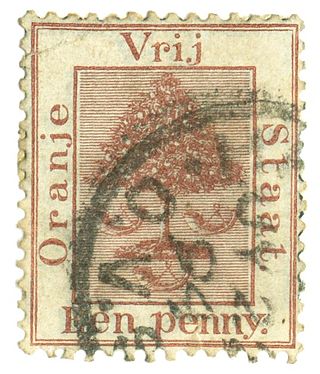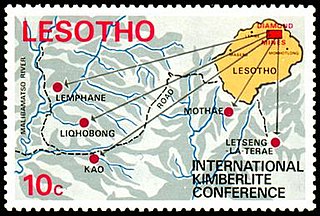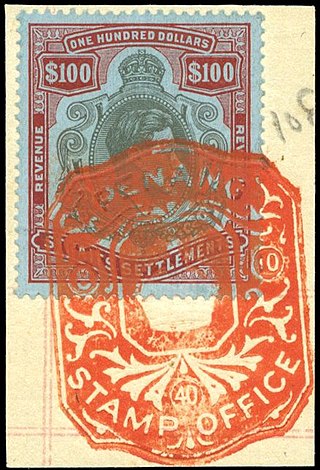
Cape of Good Hope issued revenue stamps from 1864 to 1961. There were a number of different stamps for several taxes. [1]

Cape of Good Hope issued revenue stamps from 1864 to 1961. There were a number of different stamps for several taxes. [1]
The Cape Colony's first revenues were issued in 1864. The issue consisted of eleven values ranging from ½d to £10. All stamps were imperforate and the main design was a crown. The halfpenny value was printed normally, while the other values were embossed in colour. This was replaced by an issue portraying Queen Victoria a year later. There are two types, either inscribed The Stamp Act of 1864 Cape of Good Hope or Government of Cape of Good Hope. There are several variations in perforation and watermark, as this issue remained in use for over thirty years until the end of the nineteenth century. Between 1870 and 1887, a smaller version of this design inscribed Cape of Good Hope Stamp Duty was also issued. In 1898 a new design portraying an allegorical figure of Hope was issued, with sixteen values ranging from 1d to £20. This remained in use until a new issue appeared in 1903 portraying King Edward VII, and this remained in use until being incorporated into the Union of South Africa in 1910. [2]
In 1879, Queen Victoria revenues were overprinted INSURANCE in blue. These are rare and overprints are also known inverted. Various King Edward VII postage stamps were also overprinted for various types of revenue:
Apart from these, a new design for Patent and Proprietary was issued between 1909 and 1910 for medicine duty before the Act was repealed in 1911.
When it was a colony, the Cape of Good Hope also issued a wide range of impressed duty stamps. [3]
In 1911, various high value colonial revenue issues were overprinted PENALTY to pay for the fee for late payment of duties. These were replaced by South African penalty stamps in 1913. In the 1940s, various designs featuring the South African coat of arms was issued to pay entertainments duty on theatre or film tickets. This was replaced by a numeral design around 1950. The numeral design was reissued in 1961 denominated in South African rand, and these are the last Cape revenues. [4]

After Griqualand West was annexed by the British, the first revenue stamps that were issued were Cape revenues overprinted G, in a similar manner to its postage stamps. There are various types of the overprint, and many forgeries have been made, from as early as 1900. Therefore, the only way to verify if they are genuine is if the stamps have clear cancellations of towns in Griqualand, such as Kimberley. [5]
The second series of revenue stamps was issued in 1879. This was printed in London, in a similar design to a series of Transvaal revenues which had been issued a year earlier. This series had eleven stamps with values ranging from 1d to £5. The high values are rare and are sought after by collectors. These were withdrawn a year later in 1880 when the province was annexed by the Cape Colony. [6]
Apart from the province of Griqualand West, Cape revenues were also overprinted for use in a number of other parts of Southern Africa. These were:

The Orange Free State was an independent Boer republic in southern Africa during the second half of the 19th century.
This is a survey of the postage stamps and postal history of Bechuanaland Protectorate.
Each "article" in this category is a collection of entries about several stamp issuers, presented in alphabetical order. The entries are formulated on the micro model and so provide summary information about all known issuers.

Stellaland was a short-lived Boer republic from 1882 until 1885, located in southern Bechuanaland, west of the then South African Republic, with Vryburg as its capital. It was incorporated in British Bechuanaland in 1885. British Bechuanaland was subsequently incorporated into the Cape of Good Hope in 1895.

This is a survey of the postage stamps and postal history of Cape of Good Hope.
This is a survey of the postage stamps and postal history of British Bechuanaland.

This is a survey of the postage stamps and postal history of Lesotho, formerly known as Basutoland.

This is a survey of the postage stamps and postal history of South Africa.

This is a survey of the postage stamps and postal history of Zimbabwe.

This is a survey of the postage stamps and postal history of Griqualand West, a former British colony that is now part of South Africa.

Revenue stamps of Malta were first issued in 1899, when the islands were a British colony. From that year to 1912, all revenue issues were postage stamps overprinted accordingly, that was either done locally or by De La Rue in London. Postage stamps also became valid for fiscal use in 1913, so no new revenues were issued until 1926–1930, when a series of key type stamps depicting King George V were issued. These exist unappropriated for use as general-duty revenues, or with additional inscriptions indicating a specific use; Applications, Contracts, Registers or Stocks & Shares. The only other revenues after this series were £1 stamps depicting George VI and Elizabeth II. Postage stamps remained valid for fiscal use until at least the 1980s.

South Africa issued revenue stamps from 1910 to 2009. Apart from national issues various provinces of the country issued revenues from around 1855 to c. 1970.

Revenue stamps of British Guiana refer to the various revenue or fiscal stamps, whether adhesive or directly embossed, which were issued by British Guiana prior to the colony's independence as Guyana in 1966. Between the 1860s and 1890s, the colony issued Inland Revenue and Summary Jurisdiction stamps, while revenue stamps and dual-purpose postage and revenue stamps were issued during the late 19th and 20th centuries. In around the 1890s or 1900s, British Guiana possibly issued stamps for taxes on medicine and matches, but it is unclear if these were actually issued. Guyana continued to issue its own revenue stamps after independence.

Basutoland, now known as Lesotho, first issued revenue stamps in 1900 and continues to do so.

Bechuanaland first issued revenue stamps as Stellaland in 1884. Note: this information is wrong. Bechuanaland was split into British Bechuanaland and the Bechuanaland Protectorate. British Bechuanaland was added to the Cape Colony and the Bechuanaland Protectorate was governed from Mafeking until the seat of government was moved to Gaberone.

Libya first issued revenue stamps when it was an Italian colony in 1913 and continues to do so to this day. The provinces of Cyrenaica, Tripolitania and Fezzan as well as the municipality of Tripoli also had separate revenue issues until the 1950s and 1960s.

The South African Republic (ZAR), later known as Transvaal issued revenue stamps from 1875 to around 1950. There were a number of different stamps for several taxes.

New Zealand first issued revenue stamps on 1 January 1867 and their general use continued until the early 1950s. The only Revenue Stamp series still in use today is the Game Bird Habitat stamp which is used for payment of the Gun License for the duck shooting season which begins the first weekend of May. There were various types of fiscal stamps for different taxes.

Hong Kong issued revenue stamps from 1867 to the 1990s, both when it was a British colony as well as when it was under Japanese occupation.

Malaysia first issued revenue stamps as the Straits Settlements in 1863, and continues to do so to this day. Over the years, a number of entities in modern Malaysia have issued revenue stamps.